Irish Guards
| The Irish Guards | |
|---|---|
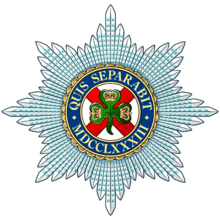 Regimental badge of the Irish Guards | |
| Active | 1 April 1900 – Present |
| Country |
|
| Branch |
|
| Type | Foot Guards |
| Role |
1st Battalion – Light Infantry/ Public Duties |
| Size | Battalion |
| Part of | Guards Division |
| Garrison/HQ |
RHQ — London 1st Battalion — Hounslow |
| Nickname(s) |
The Micks Bob's Own |
| Motto(s) |
"Quis Separabit" (Latin) "Who Shall Separate Us?" |
| March |
Quick – St Patrick's Day Slow – Let Erin Remember |
| Mascot(s) | Irish Wolfhound named Domhnall |
| Commanders | |
| Colonel in Chief | Elizabeth II |
| Colonel of the Regiment | Prince William, Duke of Cambridge KG KT |
| Insignia | |
| Tactical Recognition Flash |
 |
| Tartan | Saffron (pipes) |
| Plume |
St. Patrick's blue Right side of Bearskin cap |
| Abbreviation | IG |
The Irish Guards (IG), part of the Guards Division, is one of the Foot Guards regiments of the British Army and, together with the Royal Irish Regiment, it is one of the two Irish infantry regiments in the British Army.[1][2]
The Irish Guards recruit in Northern Ireland and the Irish neighbourhoods of major British cities.[3] Although restrictions in the Republic of Ireland's Defence Act make it illegal to induce, procure or persuade enlistment of any citizen of the Republic of Ireland into the military of another state,[4] people from the Republic do enlist in the regiment.[5]
One way to distinguish between the five regiments of Foot Guards is the spacing of the buttons on their tunics. The Irish Guards have buttons arranged in groups of four as they were the fourth Foot Guards regiment to be founded. They also have a prominent St. Patrick's blue plume on the right side of their bearskins.
History
The Irish Guards regiment was formed on 1 April 1900 by order of Queen Victoria to commemorate the Irishmen who fought in the Second Boer War for the British Empire.[6][7]
First World War
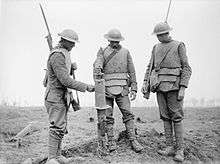
Following the outbreak of the First World War, 1st Battalion, The Irish Guards was deployed to France almost immediately, and they remained on the Western Front for the duration of the war. During the early part of the war, the battalion took part in the Battle of Mons and formed the Allied rearguard during the Great Retreat. The battalion then took part in one of the bloodiest battles of 1914, the First Battle of Ypres, which began on 19 October, which left major casualties among the old Regular Army.[8]
The 1st Battalion was involved in fighting for the duration of 'First Ypres', at Langemarck, Gheluvelt and Nonne Bosschen. The 1st Battalion suffered huge casualties between November 1–8 holding the line against near defeat by German forces, while defending Klein Zillebeke.[8]
In May 1915, the 1st Irish Guards took part in the Battle of Festubert, though did not see much action. Two further battalions were formed for the regiment in July. In September that year, the battalion, as well as the 2nd Irish Guards, who had reached France in August, took part in the Battle of Loos, which lasted from 25 September until early October. Both battalions spent the rest of 1915 in the trenches and did not fight in any major engagements.[9]
This relative quiet period for the regiment was broken on 1 July 1916 when the Battle of the Somme began. The 1st Irish Guards took part in an action at Flers–Courcelette where they suffered severe casualties in the attack in the face of withering fire from the German machine-guns. The battalion also took part in the action at Morval before they were relieved by the 2nd Irish Guards.[10]
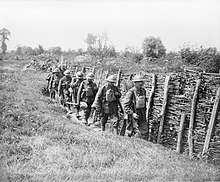
In 1917 the Irish Guards took part in the Battle of Pilckem which began on the 31 July during the Third Battle of Ypres. The Irish Guards also took part in the Battle of Cambrai in that year, the first large use of the tank in battle took place during the engagement.[11] In 1918 the regiment fought in a number of engagements during the Second Battle of the Somme, including at Arras and Albert. The regiment then went on to take part in a number of battles during the British offensives against the Hindenburg Line.[12] On 11 November 1918 the Armistice with Germany was signed. The 1st Battalion, Irish Guards were at Maubeuge when the Armistice was signed.[13]
The regiment's continued existence was threatened briefly when Winston Churchill, who served as Secretary of State for War between 1919 and 1921, sought the elimination of the Irish Guards and Welsh Guards as an economy measure. This proposal, however, did not find favour in government or army circles and was dropped. Between the wars, the regiment was deployed at various times to Turkey, Gibraltar, Egypt and Palestine.[14]
Second World War
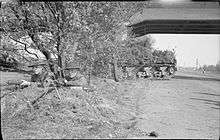
During the Second World War, battalions of the regiment fought in Norway, France, North Africa and Italy and following D-Day in France, Belgium, the Netherlands and Germany. The regiment first saw combat during the Norwegian Campaign. Following a challenging sea voyage to Norway, the 1st Irish Guards arrived in May 1940 and fought for two days at the town of Pothus before they were forced to retreat. The Irish Guards conducted a fighting withdrawal and served as the Allied rearguard.[15]
The battalion were evacuated along with the rest of the expeditionary force in June. While the 1st Irish Guards were fighting in Norway, the 2nd Battalion was deployed to the Hook of Holland to cover the evacuation of the Dutch Royal Family and Government in May 1940. 2nd Battalion were then deployed to France and ordered to defend the port of Boulogne. The guardsmen held out against overwhelming odds for three days, buying valuable time for the Dunkirk Evacuation, before they were evacuated themselves.[16] In November 1942, during the Second World War, Jean, Grand Duke of Luxembourg joined the British Army as a volunteer in the Irish Guards.[17]
All three battalions of the regiment remained based in the United Kingdom until March 1943 when the 1st Battalion landed, with the rest of the 24th Guards Brigade, in Tunisia, to fight in the final stages of the campaign in North Africa. The battalion saw extensive action while fighting through Tunisia and were subsequently deployed to the Italian Front in December of that year. The battalion took part in the Anzio landings on 22 January 1944.[18]
The Irish Guards returned to Europe in June 1944 when the 2nd and 3rd Irish Guards took part in the Normandy Campaign. Both battalions served as part of the Guards Armoured Division and took part in the attempt to capture Caen as part of Operation Goodwood. They also saw action in the Mont Pincon area. On 29 August, the 3rd Irish Guards crossed the Seine and began the advance into Belgium with the rest of the Guards Armoured Division towards Brussels. The Irish Guards were part of the ground force of Operation Market Garden, 'Market' being the airborne assault and 'Garden' the ground attack.[19]
The Irish Guards led the vanguard of XXX Corps in their advance towards Arnhem, which was the objective of the British 1st Airborne Division, furthest from XXX Corps' start line. The Corps crossed the Belgian-Dutch border, advancing from Neerpelt on 17 September but the Irish Guards encountered heavy resistance which slowed the advance.[20]
Since 1946
After the war, the regiment was reduced to a single battalion. In 1947, the 1st Irish Guards deployed to Palestine to perform internal security (IS) duties there. It was then posted to the Suez Canal Zone in Egypt, remaining there until the British withdrawal in 1956. The regiment continued to serve in troubled regions such as Cyprus and Aden throughout the 1950s and 1960s. During this time they were also part of the British Army of the Rhine (BAOR) in Germany on a number of occasions. They also served as the garrison of Hong Kong from 1970 to 1972.[21]
The Irish Guards were one of the few regiments in the British Army exempt from service in Northern Ireland during The Troubles. However, a Provisional Irish Republican Army (IRA) bomb blasted a bus carrying members of the regiment to Chelsea Barracks in October 1981. 39 people (23 soldiers and 16 others) were wounded and two civilians were killed.[22][23] 1992 saw the regiment finally carry out its first tour-of-duty in Northern Ireland, based in County Fermanagh.[21]
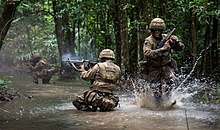
More recently, The Irish Guards were involved in the Balkans Conflicts when they were deployed to Macedonia and Kosovo in 1999 and were the first British unit to enter the Kosovan capital city of Pristina on 12 June. The regiment played a significant role in the initial stages of the Iraq War as part of the 7th Armoured Brigade and they led the British advance into Basra in March 2003.[24] In 2010, the Guards' 1st Battalion deployed on their first tour of duty during the War in Afghanistan.[25]
Following the 2017 Manchester Arena bombing, 1st Battalion, Irish Guards were deployed in London to guard key locations, including the Ministry of Defence building in Whitehall, as part of Operation Temperer.[26]
Current organisation
The 1st Battalion Irish Guards is broken down into five separate Companies; three rifle companies, No.1, No.2, and No.4 Companies, along with No.3 (Support) Company, and the Headquarters Company. The Support Company has a Recon, Anti-Tank, Sniper and Artillery Platoons.[27]
In common with the other Guards regiments, the regimental organization also includes the Band of the Irish Guards and the Corps of Drums (a fife and drum band). At a battalion level, there are also the Drum and Pipes.[28]
Structure:[29]
- Headquarters Company[30]
- Signals Platoon
- Quartermaster's Department
- Logistics Department
- REME Light Aid Detachment
- Catering Platoon
- No.1 Company
- 1 Platoon
- 2 Platoon
- 3 Platoon
- No.2 Company
- 4 Platoon
- 5 Platoon
- 6 Platoon
- No.3 (Support) Company[31]
- Mortar Platoon
- Recce Platoon
- Anti-Tank Platoon
- Sniper Platoon
- No.4 Company
- Corps of Drums Platoon
- Pipes and Drums Platoon
- Training Wing
- 10 Platoon
Uniform
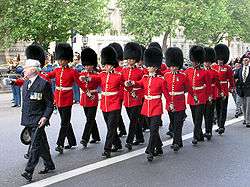
Like the other Guards regiments, the "Home Service Dress" of The Irish Guards is a scarlet tunic and bearskin. Buttons are worn in two rows of four, reflecting the regiment's position as the fourth most senior Guards regiment, and the collar is adorned with a shamrock on either side. They also sport a St. Patrick's blue plume on the right side of the bearskin.[32]
A plume of St Patrick's blue was selected because blue is the colour of the mantle and sash of the Order of St Patrick, a chivalric order.[33] founded by George III of the United Kingdom for the Kingdom of Ireland in February 1783[34] from which the regiment also draws its cap star and motto.[35]
In "Walking-out Dress", the Irish Guards can be identified by the green band on their forage caps. Officers and senior non-commissioned officers also traditionally carry a blackthorn walking stick.[36]

Like the other Guards regiments, they wear a khaki beret with the blue/red/blue Household Division backing patch on it. On the beret ranks from Guardsman to Lance Sergeant wear a brass or staybrite cap badge, Sergeants and Colour Sergeants wear a bi-metal cap badge, Warrant Officers wear a silver plate gilt and enamel cap badge and commissioned officers of the regiment wear an embroidered cap badge.[37]
The Irish Guards pipers' uniform a kilt and tunic, like The Scots Guards, yet very different. Bagpipers wear saffron kilts rather than tartan, green hose with saffron flashes and heavy black shoes known as brogues with no spats, a rifle green doublet with buttons in fours and a floppy hat known as a caubeen rather than a feather bonnet.[38]
The regimental cap star is worn over the piper's right eye and is topped by a blue hackle.[39] A green cloak with four silver buttons is worn over the shoulders and is secured by two green straps that cross over the chest.[40]
Prince William wore the uniform of the Irish Guards for his marriage to Kate Middleton.[41]
Motto
The regiment takes its motto, "Quis Separabit", or "Who shall separate us?" from the Order of St Patrick.[42]
Nickname
The Irish Guards are known affectionately throughout the Army as "the Micks" or "Fighting Micks." An earlier nickname, "Bob's Own", after Field Marshal Lord Roberts has fallen into disuse. The term "Micks", while derogatory if used in civilian life, is embraced if used within the Army.[7]
Training
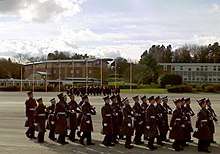
Recruits to the Guards Division go through a thirty-week training programme at the Infantry Training Centre (ITC). The training is two weeks more than the training for the Regular line infantry regiments of the British Army; the extra training, carried out throughout the course, is devoted to drill and ceremonies.[43]
Mascot
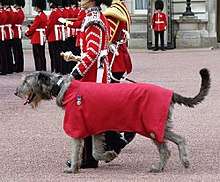
Since 1902, an Irish Wolfhound has been presented as a mascot to the regiment by the members of the Irish Wolfhound Club, who hoped the publicity would increase the breed's popularity with the public. The first mascot was called Brian Boru.[44]
In 1961, the wolfhound was admitted to the select club of "official" Army mascots, entitling him to the services of the Royal Army Veterinary Corps, as well as quartering and food at public expense. Originally, the mascot was in the care of a drummer boy, but is now looked after by one of the regiment's drummers and his family. The Irish Guards are the only Guards regiment permitted to have their mascot lead them on parade. During Trooping the Colour, however, the mascot marches only from Wellington Barracks as far as Horse Guards Parade. He then falls out of the formation and does not participate in the trooping itself. The regiment's current wolfhound is named Domhnall. His predecessor, Conmael, made his debut at Trooping the Colour on 13 June 2009.[45]
At the end of 2012 Conmael retired and was replaced with the new wolfhound- Domhnall.[46]
Traditions and affiliations
.jpg)
The Irish Guards and other Guards Regiments have a long-standing connection to The Parachute Regiment. Guardsman who have Completed P company are Transferred into the Guards Parachute Platoon who are currently attached to 3 PARA still keeping the tradition of the No 1 (Guards) Independent Parachute Company who were the original Pathfinder Group of 16th Parachute Brigade now renamed 16th Air Assault Brigade.[47]
St. Patrick's Day is the traditional regimental celebration.[48] Fresh shamrock is presented to the members of the regiment, no matter where it is stationed.[35]
Except in wartime, the presentation is traditionally made by a member of the Royal Family. This task was first performed in 1901 by HM Queen Alexandra and later by HM Queen Elizabeth The Queen Mother. After the latter's death, the presentation was made by HRH The Princess Royal. Starting in 2012, the presentation has been made by HRH the Duchess of Cambridge.[49] Her decision to skip the ceremony in 2016 to spend time with her children sparked some public controversy.[50]
Battle honours
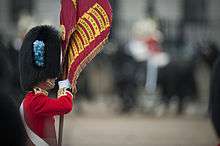
- First World War: Mons, Retreat from Mons, Marne 1914, Aisne 1914, Ypres 1914 and 17, Langemarck 1914, Battle of Gheluvelt, Nonne Bosschen, Festubert 1915, Loos, Somme 1916 and 1918, Flers–Courcelette, Morval, Pilckem, Poelcapelle, Passchendaele, Cambrai 1917 and 1918, St. Quentin, Lys, Hazebrouck, Albert 1918, Bapaume 1918, Arras 1918, Scarpe 1918, Drocourt-Quéant, Hindenburg Line, Canal du Nord, Selle, Sambre, France and Flanders 1914–18
- Second World War:
- North-West Europe: Pothus, Norway 1940, Boulogne 1940, Cagny, Mont Pincon, Neerpelt, Nijmegen, Aam, Rhineland, Hochwald, Rhine, Bentheim, North-West Europe 1940 1944–45,
- North Africa: Medjez Plain, Djebel bou Aoukaz, North Africa 1943,
- Italy: Anzio, Aprilia, Carroceto, Italy 1943–44
- Al Basrah 2003, Iraq 2003
Victoria Cross recipients
- Guardsman Edward Colquhoun Charlton, 2nd Battalion, The Irish Guards[51]
- LCpl John Kenneally, 1st Battalion, The Irish Guards
- ALt Col James Marshall, Irish Guards (attached to the 16th Battalion, The Lancashire Fusiliers)
- LSgt John Moyney, 2nd Battalion, The Irish Guards
- LCpl Michael O'Leary, 1st Battalion, The Irish Guards
- Pte Thomas Woodcock, 2nd Battalion, The Irish Guards
Notable members
- Harold Alexander, 1st Earl Alexander of Tunis
- The Rt Hon Alastair Boyd, 7th Baron Kilmarnock
- Rev. Francis Browne, SJ, MC and Bar
- The Rt Hon James Chichester-Clark DL
- Arthur Dooley
- Grand Duke Jean of Luxembourg
- Arthur Charles Evans CBE
- Sir John Gorman
- Lt John Kipling (only son of Rudyard Kipling)
- Sir Patrick Leigh Fermor DSO OBE
- Josef Locke
- Hugh Lofting
- Lt Col The Hon George Henry Morris
- Liam O'Flaherty
- The Rt Hon The Lord O'Neill of the Maine PC
- Brig JOE Vandeleur DSO and Bar
- Lt Col Giles Vandeleur DSO
- Terence Young
Regimental Colonels
British Army regiments typically have an honorary "colonel", often a member of the Royal Family or a prominent retired military officer with connections to the regiment, who functions as a kind of patron or guardian of the regiment's interests in high government circles. Queen Elizabeth II is colonel-in-chief of all Guards regiments.
The Irish Guards colonels have been:
- Field Marshal The Rt Hon The Earl Roberts VC KG KP PC GCB OM GCSI GCIE – appointed 17 October 1900.
- Field Marshal The Rt Hon The Earl Kitchener KG KP PC GCB OM GCSI GCIE – appointed 15 November 1914.
- Field Marshal The Rt Hon The Earl of Ypres KP PC GCB OM GCVO KCMG ADC – appointed 6 June 1916.
- Field Marshal The Rt Hon The Earl of Cavan KP GCB GCMG GCVO GBE DL – appointed 23 May 1925.
- Field Marshal The Rt Hon The Earl Alexander of Tunis KG PC GCB OM GCMG CSI DSO MC – appointed 28 August 1946.
- General Sir Basil Eugster KCB KCVO CBE DSO MC – appointed 17 June 1969.
- General HRH Jean, Grand Duke of Luxembourg KG – appointed 21 August 1984.[52]
- Second lieutenant His Grace The Duke of Abercorn KG – appointed 1 November 2000.
- Major General Sir Sebastian Roberts KCVO OBE – appointed 17 March 2008.
- Major HRH The Duke of Cambridge KG KT – appointed 10 February 2011.[53]
Order of precedence
| Preceded by Scots Guards |
Infantry Order of Precedence | Succeeded by Welsh Guards |
Alliances


Notes
- ↑ "The fighting Irish". The Irish Times. 31 July 2010. Retrieved 26 December 2015.
- ↑ "Kevin Myers: However we view war, let's wish our lads a safe return". Independent.ie. Retrieved 26 December 2015.
- ↑ "Joining the Army". British Army. Retrieved 26 December 2015.
- ↑ "Defence Act, 1954". Retrieved 26 December 2015.
- ↑ "Lure of combat draws Irish men and women to British army". The Irish Times. 6 September 2008.
Subscription required to view
- ↑ Bartlett, Thomas; Jeffery, Keith (1997). A Military History of Ireland. Cambridge University Press. p. 380. ISBN 0-521-62989-6. Retrieved 3 November 2010.
- 1 2 Irish Guards Regimental website Archived 8 November 2015 at the Wayback Machine.
- 1 2 Kipling, Rudyard. "1914 - Mons To La Bassée". Retrieved 26 February 2017.
- ↑ Kipling, Rudyard. "1915: La Bassée to Laventie". Retrieved 26 February 2017.
- ↑ Kipling, Rudyard. "1916: The Salient to the Somme". Retrieved 26 February 2017.
- ↑ Kipling, Rudyard. "1917: The Somme to Gouzeaucourt". Retrieved 26 February 2017.
- ↑ "World War One". Irish Guards. Archived from the original on 14 March 2016. Retrieved 1 May 2016.
- ↑ Kipling, Rudyard. "1918: Arras to the Armistice". Retrieved 26 February 2017.
- ↑ "Irish Guards 1918-1939". Irish Guards. Archived from the original on 29 July 2003. Retrieved 1 May 2016.
- ↑ Wilkinson and Astley, p. 66
- ↑ Ellis 2004, p. 157.
- ↑ "Biography of Grand Duke Jean". Luxembourg government. Retrieved 1 May 2016.
- ↑ "The Anzio Landing 22–29 January". American Forces in action. Retrieved 26 February 2017.
- ↑ Randel 2006, p. 32.
- ↑ Ryan 1999, p. 183.
- 1 2 "Irish Guards". British Army units 1945 on. Retrieved 26 February 2017.
- ↑ "Bomb Incidents (London)". Retrieved 26 December 2015.
- ↑ "Britain: Once More, Terror in the Streets". TIME.com. 9 November 1981. Retrieved 26 December 2015.
- ↑ Taylor, Matthew (13 September 2008). "Beginners luck". The Guardian. London, UK.
- ↑ "Irish Guards on tour of duty in Afghanistan". Bbc.co.uk. Retrieved 23 January 2018.
- ↑ "First Troops Deployed in Operation Temperer". Warfare.Today. Retrieved 28 May 2017.
- ↑ "The Irish Guards - The Battalion Layout". 2008-03-02. Retrieved 2018-09-09.
- ↑ "Band of the Irish Guards". Ministry of Defence. Retrieved 1 May 2016.
- ↑ "IG Regt Today". 2007-10-06. Retrieved 2018-09-26.
- ↑ "IG HQ Company". 2007-10-06. Retrieved 2018-09-26.
- ↑ "IG Sp Company". 2007-10-06. Retrieved 2018-09-26.
- ↑ Taylor, Bryn (2006). "A brief history of the regiment". Archived from the original on 15 April 2009. Retrieved 15 April 2009.
- ↑ Penny cyclopaedia of the Society for the Diffusion of Useful Knowledge, Volumes 13. C. Knight. 1839. p. 246.
|access-date=requires|url=(help) - ↑ Statutes and ordinances of the most illustrious Order of Saint Patrick, Dublin 1831, pp. 6–13.
- 1 2 "The Irish Guards - A Brief History of The Regiment". Archived from the original on 8 November 2015. Retrieved 26 December 2015.
- ↑ "Ireland's Blackthorn Stick". Tintean. Archived from the original on 2 June 2016. Retrieved 1 May 2016.
- ↑ "Irish Guards officer's embroidered cap badge". Retrieved 1 May 2016.
- ↑ "Story of the Caubeen". London Irish Rifles Association. Archived from the original on 21 May 2016. Retrieved 1 May 2016.
- ↑ "Identify the Guardsmen by their Buttons!". Royal Windsor. Retrieved 1 May 2016.
- ↑ "Everything you need to know about the Changing of the Guard at Windsor". Windsor Express. 10 March 2015. Retrieved 1 May 2016.
- ↑ "Royal wedding: Prince William marries in Irish Guards red". Telegraph.co.uk. 29 April 2011. Retrieved 1 May 2016.
- ↑ "Cambridge University Heraldic and Genealogical Society - Orders of Chivalry". cam.ac.uk. Retrieved 25 October 2010.
- ↑ "Combat Infantryman's Course – Foot Guards". Ministry of Defence. Retrieved 27 April 2014.
- ↑ "Regimental mascots - Irish Guards 1902-1910". Retrieved 26 December 2015.
- ↑ "Irish Guards Mascots 2000 to present day". Retrieved 26 December 2015.
- ↑ Ministry of Defence (3 January 2013). "Playful pup newest recruit to Irish Guards – Announcements". GOV.UK. Retrieved 26 April 2014.
- ↑ "No 1 (Guards) Independent Parachute Company". ParaData. Retrieved 26 April 2014.
- ↑ "The Irish Guards - St Patrick's Day". Archived from the original on 8 November 2015. Retrieved 26 December 2015.
- ↑ "Kate's Irish charm: An emerald Duchess presents St Patrick's Day shamrocks to guardsmen (and she's a knockout for one soldier)". Daily Mail. London, UK.
- ↑ "'She probably needs a rest!': Kate Middleton faces online backlash after breaking 115-year tradition by pulling out of presenting St Patrick's Day shamrocks to Irish Guards to spend time at home with her children". Daily Mail. London, UK.
- ↑ "Europe's Last VC — Guardsman Edward Charlton", After the Battle (magazine) No. 49, 1985. Contains additional memoirs of the surviving Irish Guards officers and men and German officers which correct the original citation.
- ↑ "The Irish Guards - A Brief History, 1980 to The Present Day". Archived from the original on 25 July 2003. Retrieved 26 December 2015.
- ↑ "Prince William becomes Colonel of the Irish Guards". The Telegraph. 10 February 2011. Retrieved 10 February 2011.
References
- The Long, Long Trail – Irish Guards
- Irish Guards.org.uk
- Verney, Peter (1970). The Micks: The Story of the Irish Guards. Peter Davis. ISBN 0-432-18650-6.
- Johnstone, Thomas (1992). Orange and Green and Khaki: The Story of the Irish Regiments in the Great War, 1914–18. Dublin: Gill and MacMillen. ISBN 978-0-7171-1994-3.
- Harris, R. G. (1988). The Irish Regiments: A Pictorial History, 1683–1987. Tunbridge Wells, Kent: Nutshell. ISBN 1-871876-00-1.
- Harris, Henry (1968). The Irish Regiments in the First World War. Cork: Mercier Press.
- Murphy, David (2007). Irish Regiments in the World Wars. Oxford: Osprey. ISBN 978-1-84603-015-4.
- Kipling, Rudyard (1923). The Irish Guards in the Great War. London.
- Wilkinson, Peter; Astley, Joan Bright (2010). Gubbins and SOE. Barnsley: Pen & Sword Military. ISBN 978-1-84884-421-6.
- Ellis, Major L. F. (2004) [1st. pub. HMSO 1954]. Butler, J. R. M., ed. The War in France and Flanders 1939–1940. History of the Second World War United Kingdom Military Series. Naval & Military Press. ISBN 978-1-84574-056-6. Retrieved 29 June 2015.
- Randel, R. A., Major P. B. (2006) [1945]. Wilson, Major D. B., ed. A short history of 30 Corps in the European Campaign 1944–1945. Crawford, W. H. (illustrator). MLRS Books. ISBN 978-1-905973-69-9.
- Ryan, Cornelius (1999) [1974], A Bridge Too Far, Wordsworth Editions, ISBN 978-1-84022-213-5
External links
| Wikimedia Commons has media related to Irish Guards. |
- British Army – Irish Guards
- The Guards Museum Containing the history of the five regiments of Foot Guards, Wellington Barracks, London.
- Ex Irish Guards tribute site
- British Army Locations from 1945 British Army Locations from 1945
- Irish soldier is injured in Afghanistan blast
- "St Patrick's Day - Quick March of the Irish Guards " on YouTube
- "Let Erin Remember - Slow March of the Irish Guards " on YouTube